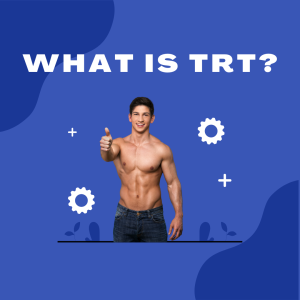Testosterone therapy has been gaining momentum in recent years as diagnosis of low testosterone becomes more common among men of all ages. Chances are if you’re on the internet you’ve probably heard of its potential benefits as well as the controversies surrounding it.
While testosterone therapy provides a solution for various health issues associated with low T, including sexual dysfunction, muscle loss, and decreased energy levels, it has also sparked concerns about potential risks as some studies have hinted at a link between testosterone therapy and increased risk of heart problems, prostate cancer, and stroke.
Experts continue studying the duration, benefits, and side effects of testosterone therapy to better understand how it works. Let us delve into everything they have discovered through research so far.

What is Testosterone Therapy?
Testosterone therapy, also known as androgen replacement therapy, is a medical treatment used to restore the levels of the hormone testosterone. Testosterone is an essential sex hormone that is produced within the testicles of men and is responsible for regulating a range of bodily functions, including the growth of facial and body hair, sperm production, libido, bone density, red blood cell production, and muscle mass. Many men experience declines in testosterone levels as they age and may require treatment to restore healthy testosterone levels.
The primary goal of testosterone therapy is to improve symptoms that may have arisen from low testosterone, such as decreased libido, erectile dysfunction, poor concentration, decreased muscle mass, infertility, night sweats, fatigue, depression, and mood swings. This treatment may also be used to treat medical conditions such as muscle wasting, osteoporosis, and delayed puberty.
Medical Treatments for Low Testosterone
Medical testosterone therapy is available as injections, dermal pellets that are inserted underneath or on the skin, or creams and gels applied directly to the skin. The type of treatment chosen will depend on an individual’s specific needs, goals, and any potential risks or side effects associated with the method of delivery.
Patches (Transdermal)
These patches can be easily applied to the skin and don’t require any preparation. They should be applied multiple times a day, however, and may cause skin irritation.
Topical Gels
These gels are applied directly to the skin and can be used to target certain areas, such as the armpits, biceps, and groin. One of the most common gels used is Testosterone 1% gel which delivers medicine directly into your bloodstream.
Buccal Patch
This is a less common option that is placed on the gums twice a day. It may, however, cause gum irritation.
Injections
For those who opt for an injection, the hormone is delivered into the muscle tissue where it can quickly enter the bloodstream for an immediate boost in hormone levels. Testosterone cypionate injection (depo-testosterone) is typically used which delivers testosterone into the bloodstream through an injection into your gluteal muscle.
Intramuscular injections are administered biweekly. This may change depending on the patient’s needs. Long-acting injections are also available that only require an injection five times a year.
Subcutaneous
Pellets are placed under the skin every three to six months, making this one of the least maintenance-intensive options. However, it does require minimal surgery for each new dose.
Oral
There are several oral formulations available (such as Kyzatrex, Jatenzo, and Tlando) that are convenient and safe to take.
Nasal
Natesto is an intranasal testosterone therapy that is administered three times a day per nostril.
Natural Testosterone Therapy
An alternative to traditional hormone replacement therapies, natural testosterone therapy involves the use of supplements, exercise, and diet to boost testosterone levels in the body. Many proponents of natural testosterone therapy claim that it is a safer option for long-term results due to the absence of synthetic hormones.
Alternative treatments include lifestyle changes and taking supplements like vitamin D and zinc. Studies have found that men who took both supplements for six months had significantly higher testosterone levels than the placebo group.
The effectiveness of natural testosterone therapy depends on how severe the testosterone deficiency is and the underlying cause of the deficiency.
Testosterone therapy should be under the guidance of a healthcare practitioner who can monitor the patient’s progress and determine if it is the right course of action. It is also essential to note that natural testosterone therapy should not be used as a replacement for medication or surgical intervention.
Who is a Good Candidate for Testosterone Therapy?
Several factors such as age, medical history, current health status, and lifestyle need to be considered before someone is deemed a good candidate.
Those who are experiencing persistent symptoms of low testosterone, such as fatigue, decreased sex drive, and mood swings, may be good candidates for therapy. Additionally, men who have undergone chemotherapy or been diagnosed with clinical hypogonadism, a condition where the body does not produce enough testosterone, may also benefit from this treatment.
Each person’s situation is unique, and it is essential to make a thoughtful, informed decision about whether testosterone therapy is right for you. The best way to determine whether you require therapy is to speak with your doctor and have a thorough evaluation of your medical history and current health status.
There are cases where the therapy is worth it, especially among individuals with a deficiency in testosterone. However, for those seeking an elixir of youth or enhanced athletic performance, testosterone therapy may not be the answer.
Benefits of Testosterone Therapy
The concept of testosterone replacement therapy might seem intimidating to some, but the benefits can be life-changing for those struggling with low testosterone levels. Increasing testosterone levels can lead to improved strength and muscle mass, higher bone density, increased energy levels, and an overall improved sense of well-being.
In addition to physical benefits, testosterone therapy can also improve mental health among men suffering from depression, anxiety, and other mood disorders. And for those struggling with sexual dysfunction related to low testosterone levels, testosterone therapy can improve sexual performance and desire.
It is essential for individuals to only use testosterone therapy under the guidance of a healthcare professional, and for healthcare providers to carefully monitor patients’ doses.
Risks and Side Effects
One potential side effect of testosterone therapy is an increased risk of blood clots, which can be dangerous and even life-threatening. Research has found that prolonged use of testosterone therapy can lead to an increased risk of stroke and cardiovascular diseases.
Other side effects include acne, breast enlargement, and fluid retention. Some studies have also found a potential link between testosterone therapy and prostate cancer.
That said, it’s important to note that not everyone who undergoes this treatment will experience these side effects. Ultimately, whether the benefits of testosterone therapy outweigh the risks will depend on your individual situation and goals. Results will also depend on your medic al history, which will be assessed by a physician.
An important aspect to consider is the potential for abuse of testosterone therapy. Some athletes and bodybuilders may use testosterone to artificially enhance their performance, which can lead to serious health complications.
Therefore, as with any medical procedure, informed consent and open communication with a healthcare provider are key to making the best possible decision for one’s health. It is essential to consult with a qualified healthcare provider who will monitor progress and assess potential side effects. With the right care and approach, testosterone therapy can lead to great results and significantly improve one’s quality of life.
Disclaimer:
The opinions shared in this article belong to the author and, like all content on Gambit’s Health Hub, should not be considered a replacement for professional medical advice, diagnosis, or treatment. If you have any health-related inquiries, consult with your preferred healthcare professional or visit a licensed, Canadian physician through Get Gambit for a supported condition.
This article has been medically reviewed by:
Dr. Taneer Ahmed, MBBS, MS[/vc_column_text][/vc_column][/vc_row]

Thanks for the useful article!
My partner and I stumbled upon this different web address and decided to check it out. Nice post, I found it both new and challenging.